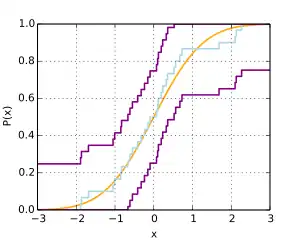Dvoretzky–Kiefer–Wolfowitz inequality
In the theory of probability and statistics, the Dvoretzky–Kiefer–Wolfowitz–Massart inequality bounds how close an empirically determined distribution function will be to the distribution function from which the empirical samples are drawn. It is named after Aryeh Dvoretzky, Jack Kiefer, and Jacob Wolfowitz, who in 1956 proved the inequality with an unspecified multiplicative constant C in front of the exponent on the right-hand side.[1] In 1990, Pascal Massart proved the inequality with the sharp constant C = 2,[2] confirming a conjecture due to Birnbaum and McCarty.[3]

The DKW inequality
Given a natural number n, let X1, X2, …, Xn be real-valued independent and identically distributed random variables with cumulative distribution function F(·). Let Fn denote the associated empirical distribution function defined by
So is the probability that a single random variable is smaller than , and is the fraction of random variables that are smaller than .
The Dvoretzky–Kiefer–Wolfowitz inequality bounds the probability that the random function Fn differs from F by more than a given constant ε > 0 anywhere on the real line. More precisely, there is the one-sided estimate
which also implies a two-sided estimate[4]
This strengthens the Glivenko–Cantelli theorem by quantifying the rate of convergence as n tends to infinity. It also estimates the tail probability of the Kolmogorov–Smirnov statistic. The inequalities above follow from the case where F corresponds to be the uniform distribution on [0,1] in view of the fact[5] that Fn has the same distributions as Gn(F) where Gn is the empirical distribution of U1, U2, …, Un where these are independent and Uniform(0,1), and noting that
with equality if and only if F is continuous.
Building CDF bands
The Dvoretzky–Kiefer–Wolfowitz inequality is one method for generating CDF-based confidence bounds and producing a confidence band. The purpose of this confidence interval is to contain the entire CDF at the specified confidence level, while alternative approaches attempt to only achieve the confidence level on each individual point which can allow for a tighter bound. The DKW bounds runs parallel to, and is equally above and below, the empirical CDF. The equally spaced confidence interval around the empirical CDF allows for different rates of violations across the support of the distribution. In particular, it is more common for a CDF to be outside of the CDF bound estimated using the DKW inequality near the median of the distribution than near the endpoints of the distribution.
The interval that contains the true CDF, , with probability is often specified as
See also
- Concentration inequality – a summary of bounds on sets of random variables.
References
- Dvoretzky, A.; Kiefer, J.; Wolfowitz, J. (1956), "Asymptotic minimax character of the sample distribution function and of the classical multinomial estimator", Annals of Mathematical Statistics, 27 (3): 642–669, doi:10.1214/aoms/1177728174, MR 0083864
- Massart, P. (1990), "The tight constant in the Dvoretzky–Kiefer–Wolfowitz inequality", Annals of Probability, 18 (3): 1269–1283, doi:10.1214/aop/1176990746, MR 1062069
- Birnbaum, Z. W.; McCarty, R. C. (1958). "A distribution-free upper confidence bound for Pr{Y<X}, based on independent samples of X and Y". Annals of Mathematical Statistics. 29: 558–562. doi:10.1214/aoms/1177706631. MR 0093874. Zbl 0087.34002.
- Kosorok, M.R. (2008), "Chapter 11: Additional Empirical Process Results", Introduction to Empirical Processes and Semiparametric Inference, Springer, p. 210, ISBN 9780387749778
- Shorack, G.R.; Wellner, J.A. (1986), Empirical Processes with Applications to Statistics, Wiley, ISBN 0-471-86725-X